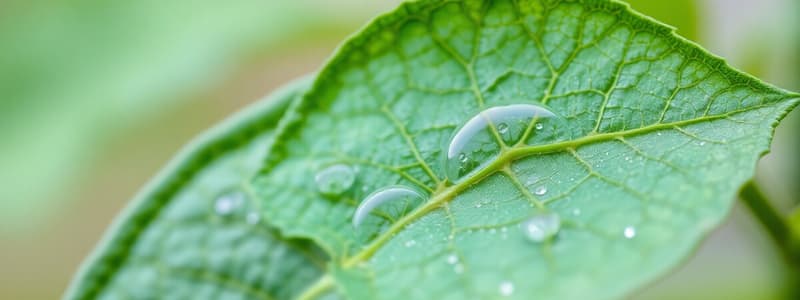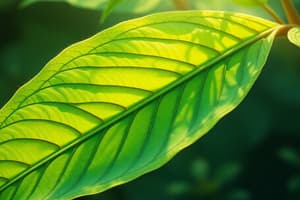Podcast
Questions and Answers
How does the waxy cuticle on the leaf's epidermis play a dual role in supporting photosynthesis?
How does the waxy cuticle on the leaf's epidermis play a dual role in supporting photosynthesis?
It reduces water loss and allows light to penetrate the leaf.
Explain how the distribution of chloroplasts within the leaf's palisade tissue is an adaptation for photosynthesis?
Explain how the distribution of chloroplasts within the leaf's palisade tissue is an adaptation for photosynthesis?
More chloroplasts in the upper palisade tissue maximize light absorption.
Describe the role of stomata in relation to the gases involved in photosynthesis.
Describe the role of stomata in relation to the gases involved in photosynthesis.
Stomata facilitate the diffusion of carbon dioxide into the leaf and oxygen out.
How does the interconnected air space system within the spongy mesophyll enhance the process of photosynthesis?
How does the interconnected air space system within the spongy mesophyll enhance the process of photosynthesis?
Summarize the functions of xylem and phloem in relation to the photosynthetic process.
Summarize the functions of xylem and phloem in relation to the photosynthetic process.
Flashcards
Waxy cuticle
Waxy cuticle
A protective layer on the leaf reducing water loss and allowing light entry.
Stomata
Stomata
Pores in the leaf that enable gas exchange; they open in light for carbon dioxide intake.
Chloroplasts
Chloroplasts
Organelles in mesophyll cells that contain chlorophyll, absorbing light energy for photosynthesis.
Palisade tissue
Palisade tissue
Signup and view all the flashcards
Xylem and phloem
Xylem and phloem
Signup and view all the flashcards
Study Notes
Leaf Adaptation for Photosynthesis
- Waxy cuticle: Reduces water loss through evaporation from the leaf. It's transparent to allow light into the leaf.
- Stomata: Open in the presence of light, allowing carbon dioxide to enter and oxygen to exit the leaf.
- Chloroplasts: Contain chlorophyll, which absorbs light energy and converts it into chemical energy stored in glucose molecules.
- More chloroplasts in upper palisade tissue: Absorbs more light near the upper leaf surface.
- Interconnecting system of air spaces: Allows rapid diffusion of carbon dioxide and oxygen in and out of mesophyll cells.
- Veins containing xylem and phloem: Xylem transports water and mineral salts to mesophyll cells; Phloem transports sucrose away from the leaf.
Studying That Suits You
Use AI to generate personalized quizzes and flashcards to suit your learning preferences.




